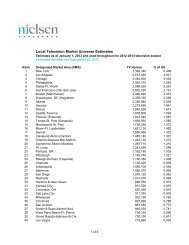TV Basics Online - Television Bureau of Advertising
TV Basics Online - Television Bureau of Advertising
TV Basics Online - Television Bureau of Advertising
Create successful ePaper yourself
Turn your PDF publications into a flip-book with our unique Google optimized e-Paper software.
<strong>TV</strong> <strong>Basics</strong><br />
Alternate Delivery Systems (ADS)<br />
<strong>TV</strong> homes with unwired cable access are referred to as having Alternate<br />
Delivery Systems. The four components <strong>of</strong> ADS are:<br />
• Direct Broadcast Satellite (DBS): Programming delivered directly via<br />
household’s own small (usually 18”) dish; DBS is the largest<br />
component <strong>of</strong> ADS.<br />
• Satellite Master Antenna (SMA<strong>TV</strong>): Serves housing complexes and<br />
hotels; signals received via satellite and distributed by coaxial cable.<br />
• Microwave Multi Distribution System (MMDS), “Wireless Cable”:<br />
Distributes signals by microwave. Home receiver picks up signal,<br />
then distributes via internal wiring.<br />
• Satellite Dish (C-Band/KU Band), “Big Dish”: Household receives<br />
transmissions from a satellite(s), via a 1- to 3- meter dish.<br />
Audience Composition<br />
The distribution <strong>of</strong> a station’s audiences by demographic group.<br />
Audience Duplication<br />
The extent to which the audience <strong>of</strong> one station is exposed to that<br />
<strong>of</strong> another.<br />
Audience Flow<br />
A measure <strong>of</strong> the change in audience during and between programs.<br />
Audience flow shows the percentages <strong>of</strong> people or households who turn<br />
on or <strong>of</strong>f a program, switch to or from another channel, or remain on the<br />
same channel as the previous program.<br />
Automated Measurement <strong>of</strong> Lineups (AMOL)<br />
The technology which allows The Nielsen Company to track an identification<br />
code within locally transmitted <strong>TV</strong> signals for network and nationally<br />
syndicated programs. Nielsen is also linked by computers to networks and<br />
syndicators in order to receive their latest schedule changes. Using this<br />
technology, Nielsen can pin down exactly what program was shown on<br />
what channel at a particular time.<br />
Average Audience (AA)<br />
A widely used rating term, expressed as a percentage, to reflect viewing<br />
to the average minute <strong>of</strong> a program or time period. It is an average <strong>of</strong><br />
the audience at minute 1, 2, 3, etc. As such, it serves as an estimate <strong>of</strong><br />
the average commercial audience (households or persons).<br />
Average Quarter-Hour Audience<br />
Estimated number <strong>of</strong> people who watch a program or station for a<br />
minimum <strong>of</strong> five minutes within a specific quarter hour.<br />
B<br />
Back Channel<br />
A means <strong>of</strong> communication from users to content providers. As content<br />
providers are transmitting interactive television (analog or digital) to<br />
users, users can connect through a back channel to a website. It can be<br />
used to provide feedback, purchase goods and services, etc.<br />
Barter<br />
The exchange <strong>of</strong> quantities <strong>of</strong> commercial time for merchandise or services.<br />
39<br />
Barter Syndication<br />
A program distribution method in which the syndicator retains and sells<br />
a portion <strong>of</strong> the show’s advertising time. In “cash plus barter,” the<br />
syndicator also receives some money from the station on which the<br />
program airs.<br />
Basic Cable<br />
Channels received by cable subscribers at no extra charge, usually<br />
supported by advertising and small per-subscriber fees paid by cable<br />
operators.<br />
Billboard<br />
A brief announcement, usually 3, 5 or 10 seconds in length, and usually<br />
earned by advertisers paying extra for the program being ordered.<br />
Billboards are afforded, in most instances, at the top and bottom (beginning<br />
and end) <strong>of</strong> the show. The product and/or sponsor’s name is mentioned<br />
in a statement such as “…the following portion <strong>of</strong> (program) is<br />
being brought to you by (sponsor)…” Also, called OPEN when used at the<br />
top <strong>of</strong> a show, and CLOSE when used at the bottom <strong>of</strong> a show.<br />
Brand Development Index (BDI)<br />
A measure <strong>of</strong> the relationship <strong>of</strong> a specific brand’s sales to population<br />
in a specific geographic area. The BDI is derived by dividing an area’s<br />
percent <strong>of</strong> total U.S. sales by that area’s percent <strong>of</strong> population.<br />
Broadband Services<br />
High-speed cable Internet, digital cable and digital phone services all<br />
through a single pipeline.<br />
Broadcast Calendar<br />
The standard Broadcast calendar, created in the 1960s, is designed<br />
to conform to the uniform billing period adopted by broadcasters,<br />
agencies and advertisers for billing and planning functions. Under this<br />
system, the standard week starts on Monday and ends on Sunday. The<br />
standard Broadcast billing month always ends on the last Sunday <strong>of</strong> the<br />
calendar month.<br />
Broadcast Coverage Area<br />
The geographic area that receives a signal from an originating <strong>TV</strong> station.<br />
C<br />
Cable <strong>Television</strong> (Cable <strong>TV</strong> or CA<strong>TV</strong>)<br />
A television distribution system whereby <strong>TV</strong> signals are transmitted via<br />
cable (insulated wire), rather than through the air, to subscribers in a<br />
community or locality. Cable television systems are generally called cable<br />
systems; the companies that own and operate them are known as cable<br />
system operators or cablecasters.<br />
Category Development Index (CDI)<br />
A measure <strong>of</strong> the relationship <strong>of</strong> a specific category’s sales to population<br />
in a specific geographic area. The CDI is derived by dividing an area’s<br />
percent <strong>of</strong> total U.S. sales by that area’s percent <strong>of</strong> population. Comparing<br />
BDI and CDI can be helpful in gauging brand or category potential.





